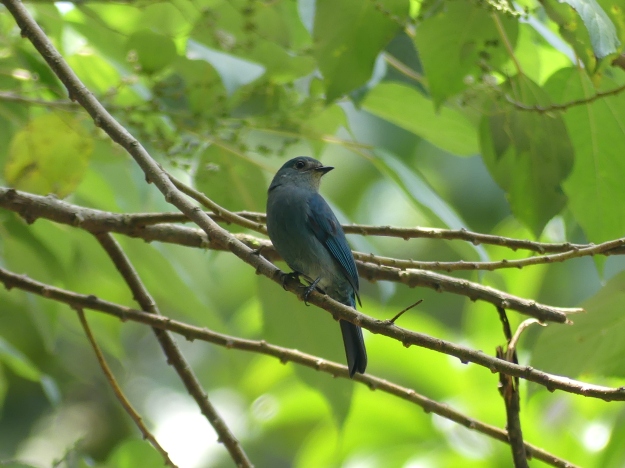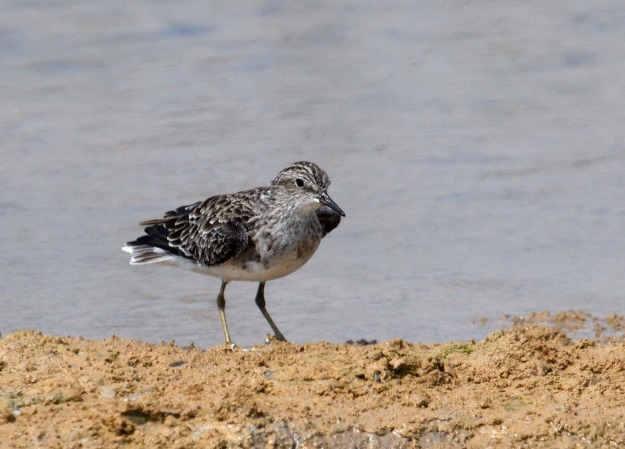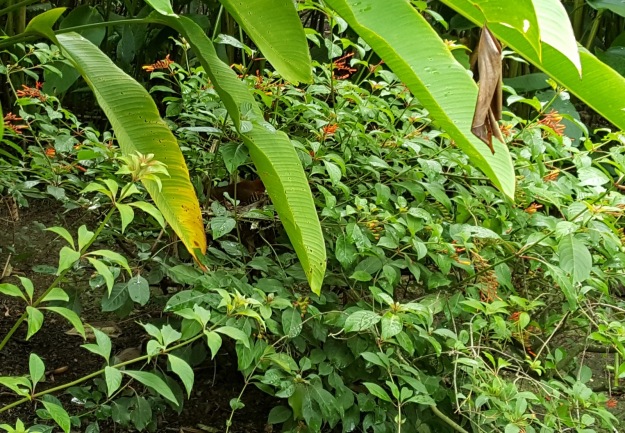 The avian phenomenon at Yishun. Hundreds of Grey Wagtails roosting with Forest Wagtails.
The avian phenomenon at Yishun. Hundreds of Grey Wagtails roosting with Forest Wagtails.
The avian phenomenon of the year had to be the congregation of wagtails at Yishun and Sembawang. On 23rd of September Shahrulbariah Arif-Sng alerted us to large flocks wagtails roosting on the palm trees at Yishun St 11 on Bird Sightings FB page. They were identified as Grey Wagtails Motacilla cinerea. Counts in early October exceeded 200. In the past we normally get to see one or two Grey Wagtails foraging at some quiet monsoon drains in the west. This large gathering has never happened here before. Another surprise was finding a small number of White Wagtails Motacilla alba and Forest Wagtails Dendronanthus indicus roosting with them. Alfred Chia managed to identify a rare lugens sub-species among the White Wagtails from photos posted. The Forest Wagtails forage at a different habitat from the other two, so how and why did they come to know about this roost was another mystery. On the 9th, Esther Ong reported another congregation of Grey Wagtails, this time at Sembawang a few kilometers away. The numbers here were just as impressive as those in Yishun. Efforts to find them in the day were not successful. We can only guess that they may be feeding somewhere in Johor. Another mystery was the absence of the Yellow Wagtails at both roosts.

Red-legged Crake nesting at SBG with the first chick just hatching. Photo: Mike Smith of AsiaPhotoStock.com
On 14th, Mike Smith made avian history when he chanced upon a nest of the Red-legged Crake Rallina fasciata with a clutch of 5 eggs, at the Singapore Botanic Gardens. He monitored the nesting and found that some of the chicks hatched on 3rd and 4th Nov. This will be the first documented nesting of this uncommon and elusive crake in Singapore.

Francis Yap’s photo of the year, a very rare vagrant, the White-throated Needletail flashing by over CCNR on 25th.
The other excitement for the month were the sightings of the White-throated Needletail Hirundapus caudacutus a very rare vagrant first photographed over Bukit Timah Hill on 5 April 2008. There have been no records since then yet there are 3 records this month alone! Keita Sin managed to photographed one flying over Henderson Wave on 19th and another on 31st. In between Francis Yap posted an excellent photo of one he shot flying over Jelutong Tower on 25th. As a bonus, Keita also shot a very rare migrant, the Asian House Martin Delichon dasypus over Henderson Wave on 19th with Francis Yap following up with another over Jelutong Towers on 20th. Well done guys!

Bidadari is still the favourite rest stop for the Brown-chested Jungle Flycatcher. Photo: Leslie Loh
This October, we welcomed back the Blue-winged Pittas Pitta moluccensis, the Brown-chested Jungle Flycatchers Cyornis brunneatus and the Siberian Blue Robins Larvivora cyane and other passerines to our forests and parklands. Bidadari is still a desirable stopover for many of our winter visitors, with the arrival of two Brown-chested Jungle Flycatchers on 5th (TT Koh). Laurence Eu had one at Labrador NR on the 24th and another seen at Rifle Range Link the next day by Francis Yap and Richard White. Con Foley had another late arrival at Bidadari on 27th. Other records came from Jurong Central and Chinese Garden, Singapore Zoo and Botanic Garden. Singapore is the best place to see this globally threatened species in the winter.
As for the Blue-winged Pitta, the first one was picked up at Jurong Island although one was heard calling on the 10th at the Bulim Forest last month. Lim Kim Chuah found it on the floor of his office building on 22nd. He managed to nurse it back for release a few days later. The one found by Jayon P. Thomas at IMH on 23rd and another by Art Toh at Labrador old flats on 27th were not so fortunate. But it was the one that ‘got lost’ and ended up at the playground at Hougang Central on 27th that became the star attraction of the month. Another one was reported at Potong Pasir by Choon Beng on 30th.
Lim Kim Chuah also found two Siberian Blue Robins, one a young male on the 22nd and the other on 23rd at his Jurong Island office. Both died as a result of window collision. Earlier on the 17th, David Tan retrieved the carcass of another dead Siberian Blue Robin from Bishan. It was killed by a cat after surviving a building collision there. Richard White reported a female at Hindhede NP on 21st.

Verditer Flycatcher, photographed by George Presanis at DFNP on 9th. Unfortunate it was not seen again. Status being reviewed by the Records Committee.
We also had three “out of range” sightings this month. A Verditer Flycatcher Eumyias thalassini was photographed by George Presanis at DFNP on 9th. Another species, the montane Little Pied Flycatcher Ficedula westermanni was reported by Dr. Niel Bruce at the downtown old Muslim Cemetery on 15th. Martin Kennewell and a few birders were at Hindhede NP looking for the Oriental Dwarf Kingfisher when they saw a Great Hornbill Buceros bicornis flying across the park. All these were not seen again. The Records Committee will be reviewing these records for their status.

Crow-billed Drongo arriving at Windsor Nature Park on 2nd. Photo: Francis Yap.
A Crow-billed Drongo Dicrurus annectans was photographed by Francis Yap at Windsor Park on 2nd. He later reported another on 25th at Rifle Range Link. A Black Drongo Dicrurus macrocercus was photographed by Hung Ting Wei off SBWR perched on the nettings. Pacific Swifts Apus pacificus were seen all over the Southern Ridges this month. Zacc HD had one over KRP on 3rd and Alan OwYong came in with a report of five on 19th there. Red-rumped Swallows Cecropis daurica were flying around the Kranji Marshes on 7th (Annual Bird Race) and photographed perched at Turuk Track on 28th by Fadzrun Adnan. The first Chestnut-winged Cuckoo Clamator coromandus was reported by Goh Juan Hui at SBWR and as expected very skittish. Another early cuckoo, the Indian Cuckoo Cuculus micropterus was reported on ebird by Martin Kennewell. It was seen at Bidadari on 17th. A third cuckoo, the Drongo Cuckoo Surniculus lugubris was reported by Seng Beng on 29th at the SBTB. Martin Kennewell picked up a first White-shouldered Starling Sturnia sinensis over at Pulau Ubin on 8th.

Black-capped Kingfisher welcoming the birders during the NSS Bird Walk at Kranji Marshes. Photo: Mahesh Krishnan
The first Oriental Dwarf Kingfisher Ceyx erithaca made a one day stop over at Hindhede NP on the 9th (Siew Mun and Francis Yap) much to the dismay of many birders and photographers. But the Ruddy Kingfisher Halcyon coromanda did not make it. David Tan showed us the carcass after it collided with a building at NUS on 16th. The wait for the Black-capped Kingfisher Halcyon pileata ended with a sighing at Marina Barrage on 20th by Zan J. The regular at the Kranji Marshes was reported by Francis Yap four days later. It was still around on 29th during the NSS Bird Walk. A Malaysian Hawk-Cuckoo Hierococcyx fugax was seen briefly at DFNP on the 10th by Alan OwYong and See Toh Yew Wai. Lee Van Hien had another at Bidadari on 25th. This non-breeding hawk-cuckoo always precedes the migratory Hodgson’s.

Ferruginous Flycatcher “Iron Boy” from Pulau Ubin on 22nd by Veronica Foo.
A dead Pallas’s Grasshopper Warbler Locustella certhiola was picked up at Changi T4 by Willie Foo on 10th. Another was reported at Kranji Marshes on 24th by Francis Yap. The rarer Lanceolated Warbler Locustella lanceolata was found by James Lambo on 29th at Tuas South. The first Ferruginous Flycatcher Muscicapa ferruginea was reported by Avinash Sharma at MacRitchie Park on 15th. Veronica Foo had a juvenile at Pulau Ubin on 22nd while conducting the Fall Migration Bird Census. An unconfirmed record came from Bidadari during the last week of the month.

A very fortunate Laurence Eu was at the right place and time to snap this rare passage migrant, a Japanese Paradise Flycatcher, at Labrador Nature Reserve on 24th.
The rare Japanese Paradise Flycatcher Terpsiphone atrocaudata made a one day stop over at the Labrador NR on 24th. Laurence Eu was at the right place and time to captured it on his camera’s sensor. Last year he also found the one at the Zoo on 31st October. We ended the month with an Ashy Minivet Pericrocotus divaricatus at Kranji Marshes (Veronica Foo) and a spectacular flypast of 66 Oriental Pratincoles Glareola maldivarum across Jelutong Tower was captured by Goh Cheng Teng. One was reported by Martin Kennewell earlier on 22nd at the Kranji Marshes.

A lone Sanderling turned up at the Marina Barrage on 14th. Luke Milo Teo was there to snap it up. Another new species to add to this city waterfront.
The breakwaters next to Marina Barrage continue to attract interesting shorebirds like the juvenile Sanderling Calidris alba on 12th (Luke Milo Teo). This was where a Little Ringed Plover Charadrius dubius was reported two days earlier by TT Koh. The number of Red-necked Stints Calidris ruficollis at Marina Barrage went up to four on 17th (Alan OwYong).

A fresh water loving Long-toed Stint at Pulau Tekong. Photo: Frankie Cheong.
A rather greyish Long-toed Stint Calidris subminuta and Wood Sandpipers Tringa glareola were at Frankie Cheong’s restricted site at Pulau Tekong on 21st. Two more Wood Sandpipers were seen at the Kranji Marshes together with a Common Snipe Gallinago gallinago on 29th during a Bird Group walk (Lee Ee Ling/ Yap Wee Jin). These fresh water shorebirds are the one that Nparks wants to bring in to the marshes.

A non-breeding Little Ringed Plover beautifully taken at the Marina Barrage by Pary Sivaraman
Larger waterbirds sighted include a Black-tailed Godwit Limosa limosa and Chinese Egret Egretta eulophotes at Pulau Tekong on 9th and 10th (Frankie Cheong), a Pacific Reef Egret Egretta sacra showing up at Marina Barrage on 16th (Siew Mun), a Black Bittern Dupetor flavicollis found dead at Jurong West on 23th by Ben Choo and another, very much alive was photographed at SBTB on 27th by Robin Tan.
Notable residents reported this month were the rare Lesser Green Leafbird Chloropsis cyanopogon at BTNR by James Lambert on 15th. A sizable flock of 10 Green Imperial Pigeons Ducula aenea present at PRP on the 9th (Seng Alvin), up to 20 House Swifts Apus nipalensis over at KRP out hawking for insects in the evening of the 19th (Alan OwYong) and a large flock of 26 Lesser Whistling Ducks Dendrocygna javanica being flushed out at Kranji Marshes on 22nd (Martin Kennewell). Good to see that they are returning to Kranji Marshes. Both the House Swift’s and Whistling Ducks numbers were the highest for some time.
Francis Yap and company organised the only pelagic in the Singapore Strait (a multi-national stretch of water) for the month on 14th and returned with a Parasitic Jaeger, Stercorarius parasiticus, a few Aleutian Onychoprion aleuticus and Bridled Terns Onychoprion anaethetus among others.

Parasitic Jaeger migrating through the Straits of Singapore by See Toh Yew Wai during this month’s Pelagic trip.
——————————–
Location abbreviations: SBG Singapore Botanic Gardens, IMH Institute of Mental Health, DFNP Dairy Farm Nature Park, KRP Kent Ridge Park, NUS National University of Singapore.
References:
Lim Kim Seng. The Avifauna of Singapore. 2009. Nature Society (Singapore).
Yong Ding Li, Lim Kim Chuah and Lee Tiah Khee. A Naturalist’s Guide to the Birds of Singapore. 2013. John Beaufoy Publishing Limited.
Craig Robson. A Field Guide to the Birds of Thailand and South East Asia. 2000.
This report is compiled by Alan OwYong and edited by Tan Gim Cheong from selected postings in various facebook birding pages, bird forums, individual reports and extracts from ebird. This compilation is not a complete list of birds recorded for the month and not all the records were verified. We wish to thank all the contributors for their records. Many thanks to Alan OwYong, Mike Smith, Francis Yap, Leslie Loh, George Presanis, Mahesh Krishnan, Veronica Foo, Laurence Eu, Frankie Cheong, Luke Milo Teo, Pary Sivaraman and See Toh Yew Wai for the the use of their photos. Please notify alan.owyong@gmail.com if you find errors in these records.















 The avian phenomenon at Yishun. Hundreds of Grey Wagtails roosting with Forest Wagtails.
The avian phenomenon at Yishun. Hundreds of Grey Wagtails roosting with Forest Wagtails. 









